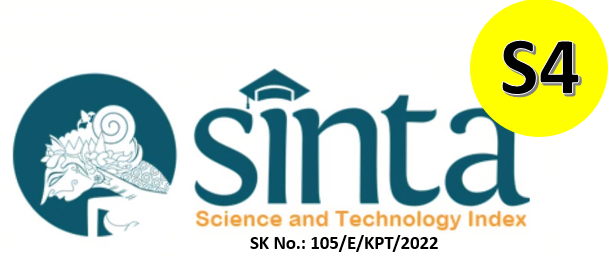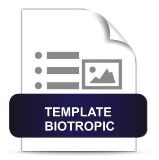Potensi Ekstrak Daun Bandotan (Ageratum conyzoides L.) Sebagai Spray Untuk Pemulihan Luka Mencit Diabetik Yang Terinfeksi Staphylococcus aureus
DOI:
https://doi.org/10.29080/biotropic.2019.3.1.68-78Keywords:
Spray, Ageratum conyzoides L, Diabetic Ulcers, Staphylococcus aureusAbstract
Ageratum conyzoides L. leaf has the main compound of flavonoids and alkaloids that contribute to accelerate the healing process of diabetic ulcers with Staphylococcus aureus infection that can affect the quality of life of patients. This study aims to test the leaves of Ageratum conyzoides L. on the recovery of diabetic ulcers of mice infected with Staphylococcus aureus. The method used is the extraction of Ageratum conyzoides L leaves as the material of spray 15%, induction of diabetic compound (Alloxan monohydrate), length wound (1cm) and bacterial infections, and spray application with 1 times daily frequency, 2 times daily, 3 times a day for 9 days. The results showed that the lenght of wounds in group A, B, C, D, and E were 0,5; 0,8; 0,4; 0,2; 0,0. The administration of Ageratum conyzoides L. spray which has active flavonoide substances, alkaloid substance, and saponin substances has an effect on decreased length of diabetic wounds and restoration of dermis tissue structure (increases epithelial cells proliferation, initiates fibroblast cells, and stimulates type 1 collagen). Spray treatment 3 times a day (group E) was more influential than the other treatments, which experienced wound closure in 9 days. Thus, Ageratum conyzoides L. leaf spray is potential for therapy of diabetic ulcers infected with Staphylococcus aureus.
Downloads
References
Amadi, B., Duru M, dan Agomuo E. 2012. Chemical profilesof leaf, stem, root and flower of Ageratum conyzoides. Asian Journal of Plant Science and Research. 2 (4): 428-432.
Arianingsih, EP., Uno, WD. and Kumaji, SS. 2015. Pengaruh Ekstrak Daun Tanaman Yodium (Jatropha Multifida L.) Terhadap Pertumbuhan Bakteri Staphylococcus aureus. Universitas Negeri Gorontalo Fakultas Matematika dan IPA Jurusan Biologi. 3p.
Astuti, H. 2015. Uji Aktivitas Antibakteri Ekstrak Etanol Dan Ekstrak Air Daun Bandotan (Ageratum conyzoides, L.) Terhadap Staphylococcus aureus Dan Escherichia coli. Majalah Farmaseutik. 11(1): 290-293.
Broughton, GG., Janis, JE. and Attinger, CE. 2006. Wound healing: an overview. Plast Reconstr Surg, 117(7 Suppl).
Diegelmann, RF., and Evans, MC. 2004. Wound Healing : An Overview of Acute, Fibrotic and Delayed Healing. Bioscience. 9: 283-289.
Guo, S., and DiPietro, LA. 2010. Oxidative Stress and Diabetic Complications Circ. Res. 107(9): 1058-1070.
Gupta, N dan Jain UK. 2010. Prominent wound healing properties of indigenous medicines. J Nat Pharmaceutic. 2010(1) :2-10.
Gurtner, GC. and Wong, VW., 2007. Wound healing: normal and abnormal. Grabb and Smith’s plastic surgery. 6: 15-22.
Hastuti, RT. 2008 . Faktor-Faktor Risiko Ulkus Diabetes pada Penderita Diabetes Mellitus (Studi Kasus Di RSUD Dr. Moewardi Surakarta). Semarang: Universitas Diponegoro, Program Studi Magister Epidemiologi, Program Pasca Sarjana.
Igafur, RHR., Ayu, WD., and Masruhim, MA. 2016. Uji Aktivitas Ekstrak Metanol Daun Bandotan (Ageratum Conyzoides Linn.) Terhadap Penyembuhan Luka Bakar Pada Tikus Putih (Rattus norvegicus). InProceeding of Mulawarman Pharmaceuticals Conferences. 3: 335-339).
Kementrian Kesehatan RI. 2017. Tahun 2030 Prevalensi Diabetes Melitus Di Indonesia Mencapai 21,3 Juta Orang. Depkes.go,online (http://www.depkes.go.id diakses pada tanggal 19 Sep. 17).
Mahibalan, S., Stephen, M., Nethran, RT., Khan, R. and Begum, S. 2016. Dermal wound healing potency of single alkaloid (betaine) versus standardized crude alkaloid enriched-ointment of Evolvulus alsinoides. Pharmaceutical biology. 54(12): 2851-2856.
Miladiyah, I., Prabowo, BR. 2012. Ethanolic Extract of Anredera cordifolia (Ten.) Steenis Leaves Improved Wound Healing in Guinea Pigs. Univ Med. 31(1) : 4-11.
Muralidhar, A., Babu, KS., Sankar, TR., Reddanna, P., dan Latha, J. 2013. Wound Healing Activity of Flavonoid Fraction Isolated From the Stem Bark of Butea monosperma (lam) in Albino Wistar Rats. European Journal of Experimental Biology. 3(6): 1-6.
Mustafa, MR., Mahmood, AA., Sidik, K. and Noor, SM. 2005. Evaluation of wound healing potential of Ageratum conyzoides leaf extract in combination with honey in rats as animal model. Int J Mol Med Adv Sci. 1(4): 406-410
Reyes, BHP., Lewis, WH., Roman, J., Simchowitz, L., dan Mustoe, TA. 1993. Enhancement of Wound Healing by The Alkaloid Taspine Defining Mechanism of Action. Exp Biol Med. 203(1): 18-25.
Sachin, J., Neetesh, J., Tiwari, A., Balekar, N. and Jain, DK. 2009. Simple evaluation of wound healing activity of polyherbal formulation of roots of Ageratum conyzoides Linn. Asian J Res Chem. 2(2): 135-138.
Sartika, DD. 2010. Efek lumatan daun dewa (Gynura segetum) dalam memperpendek waktu penyembuhan luka bersih pada tikus putih. Jurnal Keperawatan Soedirman, 5(3): 127-135.
Smeltzer, SC., dan Bare BG. 2008. Buku Ajar Keperawatan Medikal Bedah Brunner & Suddarth. Jakarta: EGC.
Stocks, J., Gutteridge JM., Sharp RJ., dan Doemandy TL. 1974. The Inhibition of Lipid Autoxidation by Human Serum and Its Relation To Serum Proteins and Tocopherol. Clin Sci Mol Med. 47: 223-233.
Sugara, TH., 2011. Karakterisasi Senyawa Aktif Antibakteri Dari Fraksi Etil Asetat Daun Tanaman Bandotan (Ageratum conyzoides L.).
O’Brien, M. 2002. Exploring methods of wound debridement. British journal of community nursing. 7(3): 1018.













